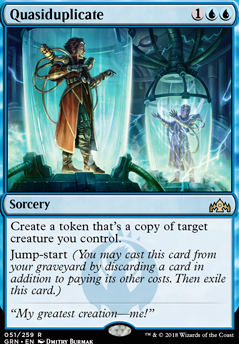Land (37)
- 1x Buried Ruin
- 1x Command Tower
- 1x Desert of the Fervent
- 1x Desert of the Indomitable
- 1x Desert of the Mindful
- 1x Exotic Orchard
- 4x Forest
- 1x Frontier Bivouac
- 1x Fungal Reaches
- 1x Game Trail
- 1x Gruul Turf
- 1x Hinterland Harbor
- 6x Island
- 1x Izzet Boilerworks
- 1x Llanowar Reborn
- 3x Mountain
- 1x Novijen, Heart of Progress
- 1x Opal Palace
-
1x
Oran-Rief, the Vastwood

- 1x Ramunap Ruins
- 1x Reliquary Tower
- 1x Rupture Spire
- 1x Scavenger Grounds
- 1x Simic Growth Chamber
- 1x Spire of Industry
- 1x Steam Vents
- 1x Thespian's Stage
Anthem (3)
Protection (3)
AltWinCon (2)
TargetedRemoval (2)
Clone (16)
- 1x Altered Ego
- 1x Body Double
- 1x Cackling Counterpart
- 1x Clever Impersonator
- 1x Dack's Duplicate
- 1x Experiment Kraj
- 1x Mirage Mirror
-
1x
Phyrexian Metamorph

- 1x Progenitor Mimic
- 1x Quasiduplicate
- 1x Rite of Replication
- 1x Saheeli's Artistry
- 1x Spitting Image
- 1x Supplant Form
- 1x Tempt with Reflections
- 1x Twincast
Ramp (10)
- 1x Collective Voyage
- 1x Cultivate
- 1x Fellwar Stone
- 1x Gilded Lotus
- 1x Hour of Promise
- 1x Incubation Druid
- 1x Map the Wastes
- 1x Marwyn, the Nurturer
- 1x Sylvan Scrying
- 1x Unexpected Results
TokenGenerator (4)
Steal (3)
BoardWipe (2)
SecretCommander (1)
Commanders (2)
CardDraw (5)
- 1x Bred for the Hunt
-
1x
Fathom Mage

- 1x Shapers of Nature
- 1x Toothy, Imaginary Friend
-
1x
Zameck Guildmage

CounterCreation (4)
CounterMover (3)
Tutor (3)
Maybeboard
Other (23)
- 1x Arcane Lighthouse
- 1x Ashling the Pilgrim
- 1x Bonds of Mortality
- 1x Death's Presence
- 1x Dragon Throne of Tarkir
- 1x Emergence Zone
- 1x Followed Footsteps
- 1x Forge of Heroes
- 1x Giant Adephage
- 1x Gigantoplasm
- 1x Gilder Bairn
- 1x Harrow
- 1x Hashep Oasis
- 1x Ipnu Rivulet
- 1x Karametra's Favor
- 1x Karn's Bastion
- 1x Mirror Gallery
- 1x Mycoloth
- 1x Ooze Flux
- 1x Presence of Gond
-
1x
Reverberate

- 1x Vedalken Orrery
- 1x Vivien, Champion of the Wilds
Suggestions
Updates Add
Comments
Attention! Complete Comment Tutorial! This annoying message will go away once you do!
Important! Formatting tips — Comment Tutorial — markdown syntax
Please login to comment
98% Casual
Competitive
| Date added | 5 years |
| Last updated | 4 years |
| Legality | This deck is Commander / EDH legal. |
| Rarity (main - side) | 12 - 0 Mythic Rares 42 - 0 Rares 22 - 0 Uncommons 11 - 0 Commons |
| Cards | 100 |
| Avg. CMC | 3.81 |
| Tokens | Copy Clone, Ooze 2/2 G, Myr 2/1 U, Saproling 1/1 G, Zombie 2/2 B |
| Votes | |
| Ignored suggestions | |
| Shared with | |
| Views |


